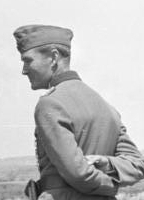| Joachim von Kortzfleisch | |
|---|---|
 General Kortzfleisch in Romania, 1941 General Kortzfleisch in Romania, 1941 | |
| Born | (1890-01-03)3 January 1890 Braunschweig, German Empire |
| Died | 20 April 1945(1945-04-20) (aged 55) Sauerland, Germany |
| Allegiance | |
| Service | Army |
| Rank | General der Infanterie |
| Commands | 1st Infantry Division Military District III (Berlin) |
| Battles / wars | World War I
World War II |
| Awards | Knight's Cross of the Iron Cross |
Joachim Otto August Achatius von Kortzfleisch (3 January 1890 – 20 April 1945) was a German general in the Wehrmacht during World War II. As the commander of the Military District III (Berlin), he played a role in the failure of the attempted coup following the 20 July Plot attempt to assassinate Adolf Hitler, which was led by Kortzfleisch's own distant cousin, Claus von Stauffenberg.
Biography
Von Kortzfleisch was born into an aristocratic Westphalian family in Braunschweig, Duchy of Brunswick, the son of the Prussian Major General Gustav von Kortzfleisch (1854–1910) and Elsbeth (née Oppermann; 1862-1937). He joined the army in 1907 and after service in World War I in a machine gun battalion he was an officer in the Reichswehr, reaching the rank of Generalmajor by 1937. He was a Generalleutnant and commander of the 1st Infantry Division at the outbreak of World War II and was awarded the Knight's Cross of the Iron Cross on 1 September 1940 as commander of the XI Army Corps of the Wehrmacht.
20 July Plot
On 20 July 1944 as the commander of the Military District III (Berlin) Von Kortzfleisch was summoned to the Bendlerstrasse by General Friedrich Fromm. When he arrived, he was perplexed to see that Fromm was no longer in command, that Ludwig Beck was now in control. He angrily refused to obey Operation Valkyrie orders issued by one of the leading conspirators General Friedrich Olbricht and kept shouting ‘the Führer is not dead’ and referring to the oath of loyalty to Hitler. He was arrested and put under guard by the plotters and said that he was not willing to take part in a coup as he was just a soldier interested only in going home and pulling weeds in his garden.
He was replaced in his command by General Karl Freiherr von Thüngen and was later allowed to leave the Bendlerblock. He subsequently interrogated Major Hans-Ulrich von Oertzen, a supporter of the plot. Kortzfleisch was later shocked to learn that the officer leading the plot was his own distant cousin Claus von Stauffenberg, with whom he had attended a wedding the previous year.
Death
In March 1945, Von Kortzfleisch was commanding the Rhine Bridgehead in Army Group B under Field Marshal Walter Model. Kortzfleisch and a handful of soldiers were attempting move through enemy lines to reach Berleburg, when a patrol of the 737th Tank Battalion of the United States Army encountered them at Schmallenberg-Wulwesort, Sauerland.
The general was surrounded by U.S. soldiers and told to put his hands up. Kortzfleisch refused to comply with this command and was promptly fatally shot in the chest by a U.S. soldier.
Awards and decorations
- Knight's Cross of the Iron Cross on 4 September 1940 as General der Infanterie and commander of XI. Armeekorps
References
Citations
- Veit Scherzer: Ritterkreuzträger 1939–1945. Die Inhaber des Eisernen Kreuzes von Heer, Luftwaffe, Kriegsmarine, Waffen-SS, Volkssturm sowie mit Deutschland verbündete Streitkräfte nach den Unterlagen des Bundesarchivs. 2. Auflage, Scherzers Militaer-Verlag, Ranis/Jena 2007, ISBN 978-3-938845-17-2, S. 467.
- Michael C Thomsett (1997). The German Opposition to Hitler: The Resistance, the Underground, and Assassination Plots, 1938-1945. McFarland. ISBN 0-7864-0372-1.
- Joachim Fest (1994). Plotting Hitler's Death: The German Resistance to Hitler, 1933-1945. Weidenfeld & Nicolson. ISBN 0-297-81774-4.
- Augenzeugenbericht der „Fünften Infanterie Division der US-Streitkräfte“, abgedruckt im Jahrbuch Hochsauerlandkreis 1995, ISBN 3-86133-126-8, übersetzt von Frank Muermann und Rudolf Salingré, S. 70.
- Fellgiebel 2000, p. 270.
- Scherzer 2007, p. 467.
Bibliography
- Fellgiebel, Walther-Peer (2000) . Die Träger des Ritterkreuzes des Eisernen Kreuzes 1939–1945 — Die Inhaber der höchsten Auszeichnung des Zweiten Weltkrieges aller Wehrmachtteile [The Bearers of the Knight's Cross of the Iron Cross 1939–1945 — The Owners of the Highest Award of the Second World War of all Wehrmacht Branches] (in German). Friedberg, Germany: Podzun-Pallas. ISBN 978-3-7909-0284-6.
- Scherzer, Veit (2007). Die Ritterkreuzträger 1939–1945 Die Inhaber des Ritterkreuzes des Eisernen Kreuzes 1939 von Heer, Luftwaffe, Kriegsmarine, Waffen-SS, Volkssturm sowie mit Deutschland verbündeter Streitkräfte nach den Unterlagen des Bundesarchives [The Knight's Cross Bearers 1939–1945 The Holders of the Knight's Cross of the Iron Cross 1939 by Army, Air Force, Navy, Waffen-SS, Volkssturm and Allied Forces with Germany According to the Documents of the Federal Archives] (in German). Jena, Germany: Scherzers Militaer-Verlag. ISBN 978-3-938845-17-2.
| Military offices | ||
|---|---|---|
| Preceded byGeneralleutnant Walther Schroth | Commander of 1. Infanterie-Division 1 January 1938 – 14 April 1940 |
Succeeded byGeneralleutnant Philipp Kleffel |
| Preceded byGeneral der Artillerie Emil Leeb | Commander of XI. Armeekorps 1 March 1940 – 6 October 1941 |
Succeeded byGeneral der Infanterie Eugen Ott |
| Preceded byGeneral der Infanterie Eugen Ott | Commander of XI. Armeekorps 10 December 1941 – 1 June 1942 |
Succeeded byGeneraloberst Karl Strecker |
| Preceded byGeneral der Infanterie Kurt Brennecke | Commander of XXXXIII. Armeekorps 28 June 1942 - 15 August 1942 |
Succeeded byGeneral der Infanterie Kurt Brennecke |
- 1890 births
- 1945 deaths
- Military personnel from Braunschweig
- German Army generals of World War II
- German Army personnel of World War I
- Generals of Infantry (Wehrmacht)
- Recipients of the clasp to the Iron Cross, 1st class
- Recipients of the Knight's Cross of the Iron Cross
- Westphalian nobility
- German Army personnel killed in World War II
- Deaths by firearm in Germany
- Reichswehr generals